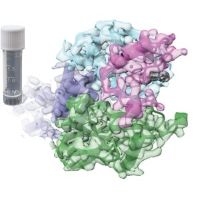Specification
| Description | Recombinant protein from the full-length sequence of homo sapiens serine palmitoyltransferase small subunit B (SPTSSB), transcript variant 2 (NM_001040100). |
| Organism | Homo sapiens (Human) |
| Expression Host | Human Cells |
| Tag Info | His or DYKDDDDK. Please contact us if you need further information or require specific designed tag. |
| Purity | Greater than 90% by SDS-PAGE gel |
| Uniprot ID | Q8NFR3 |
| Entry Name | SPTSB_HUMAN |
| Gene Names | SPTSSB ADMP C3orf57 SSSPTB |
| Alternative Gene Names | ADMP C3orf57 SSSPTB |
| Alternative Protein Names | Serine palmitoyltransferase small subunit B (Protein ADMP) (Small subunit of serine palmitoyltransferase B) (ssSPTb) |
| Application | Antigens, Western, ELISA and other in vitro binding or in vivo functional assays, and protein-protein interaction studies; For research & development use only! |
| Buffer | Purified protein formulated in a sterile solution of PBS buffer, pH7.2, without any preservatives |
| Endotoxin | Endotoxin level is < 0.1 ng/µg of protein (<1EU /µg) |
| Length | 76 |
| Molecular Weight(Da) | 9198 |
| Protein Sequence | (The sequence of expressed protein may have some variation from the sequence shown below. Please contact us for the exact sequence.) MDLRRVKEYFSWLYYQYQIISCCAVLEPWERSMFNTILLTIIAMVVYTAYVFIPIHIRLAWEFFSKICGYHSTISN |
Background
| Function | FUNCTION: Stimulates the activity of serine palmitoyltransferase (SPT). The composition of the serine palmitoyltransferase (SPT) complex determines the substrate preference, complexes with this subunit showing a clear preference for longer acyl-CoAs. The SPTLC1-SPTLC2-SPTSSB complex shows a strong preference for C18-CoA substrate, while the SPTLC1-SPTLC3-SPTSSB isozyme displays an ability to use a broader range of acyl-CoAs, without apparent preference. May play a role in signal transduction. {ECO:0000269|PubMed:19416851}. |
| Pathway | Lipid metabolism; sphingolipid metabolism. |
| Protein Families | SPTSS family, SPTSSB subfamily |
| Tissue Specificity | Expression is seen predominantly in the prostate epithelium with weaker expression in the fibroblasts and endothelial cells. {ECO:0000269|PubMed:15777716}. |
QC Data
| Note | Please contact us for QC Data |
| Product Image (Reference Only) |  |

